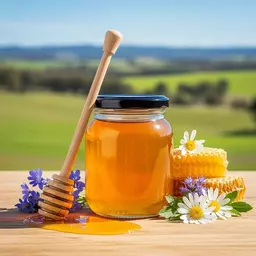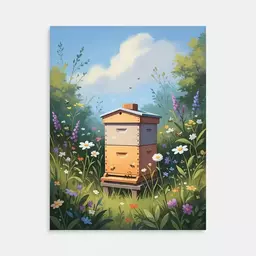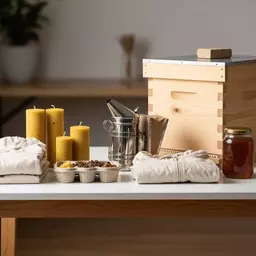Designing Your First Apiary Layout

Choosing the right layout for your apiary can significantly impact both bee health and honey production. Let’s explore some essential insights that will guide you in creating an optimal environment for your bees!
What You Will Learn
- An efficient apiary layout optimizes bee movement and eases hive management.
- Proper hive placement minimizes stress on bees and enhances their foraging capabilities.
- Choosing the right bee species is crucial for productivity and adaptability to your local environment.
- Avoid common pitfalls in apiary design, such as inadequate spacing and neglecting local zoning laws.
- Regular monitoring and cleanliness are key to maintaining bee health and preventing diseases.
- Engagement with local beekeeping communities can provide valuable support and resources for new beekeepers.
Key Elements for an Efficient Apiary Layout
An effective apiary layout involves thoughtful planning to ensure the health and productivity of your bees. The visual below highlights the crucial components for beginners to consider.
Strategic Hive Placement
Optimizes natural bee traffic & foraging.
Easy Accessibility
Facilitates monitoring & maintenance.
Ample Sunlight Exposure
Promotes healthy bee activity.
Understanding Apiary Layout and Its Importance for Beginners
When I first started beekeeping, I quickly learned that the layout of an apiary is not just about placing hives in a sunny spot. It's an art that requires thoughtful planning to ensure the health and productivity of your bees. An efficient apiary layout can make all the difference for beginners, helping them establish a thriving environment for their colonies. Let's dive into what makes an apiary layout effective!
What is an Efficient Apiary Layout?
An efficient apiary layout is designed to optimize the flow of bees while providing easy access for the beekeeper. This involves strategic placement of hives, ensuring adequate space for bee movement, and creating paths that allow for easy management. Here are some key components to consider:
- Hive Placement: Position hives in a way that allows for natural bee traffic.
- Accessibility: Design pathways that facilitate easy monitoring and maintenance.
- Sunlight Exposure: Ensure hives receive ample sunlight to promote healthy bee activity.
By focusing on these elements, you can create an environment where bees thrive, and managing your hives becomes a less daunting task!
Why Proper Hive Placement Matters for Beekeeping Success
Proper hive placement is crucial for a variety of reasons. First, it directly impacts how well your bees can forage and interact with their surroundings. When hives are optimally placed, bees can easily access nearby floral sources, which contributes to their overall health and honey production. For comprehensive guidelines on best management practices for healthy honey bee colonies, you can refer to resources like the Honey Bee Health Coalition's Hive Management Best Practices. Here are a few reasons to keep hive placement in mind:
- Minimized Stress: Well-placed hives reduce stress on bees as they navigate to and from their foraging areas.
- Enhanced Security: Strategic positioning can protect hives from extreme weather and potential predators.
- Improved Pollination: Bees can effectively pollinate nearby crops and flowers, benefiting both the ecosystem and your honey yield.
As I learned through experience, taking the time to think about hive placement can have significant long-term benefits for both your bees and your honey harvest!
Choosing the Right Bee Species for Your Apiary
Choosing the right bee species is just as important as laying out your apiary. Different bee species have varied temperaments, productivity levels, and resistance to disease. For beginners, I often recommend considering the following options:
- Italian Bees: Known for their gentle nature and strong honey production.
- Carniolan Bees: Excellent foragers and known for their ability to adapt to changing conditions.
- Russian Bees: Resistant to cold and diseases, making them a resilient choice for various climates.
By selecting a bee species that fits your local environment and personal preferences, you can set yourself up for a successful beekeeping journey! At Nectar Network, we believe that understanding the unique traits of each species is essential for fostering a thriving apiary.
Key Considerations for Designing Your Apiary Layout
Now that we understand the basics of apiary layout, let's talk about some key considerations that can enhance your setup!
Pro Tip
Did you know that incorporating companion plants around your apiary can significantly enhance bee foraging? Plants like borage, lavender, and sunflowers not only attract bees but also provide essential nutrients that support their health. Consider planting these around your hives to create a vibrant ecosystem that benefits both your bees and your garden!
Summarizing Best Practices for an Efficient Apiary Layout
Designing an efficient apiary layout is crucial for both novice and experienced beekeepers. At Nectar Network, we understand that an effective setup can make all the difference in your beekeeping success. For detailed guidance on best management practices, you can review resources like the San Diego County Department of Agriculture's Bee BMPs. Here are some common mistakes to avoid when planning your apiary:
- Neglecting sunlight exposure: Always consider how sunlight will hit your hives.
- Inadequate spacing between hives: Crowded hives can lead to stress and disease.
- Ignoring local zoning laws: Make sure your apiary complies with local regulations.
- Failing to plan for future expansion: As your experience grows, your apiary should be able to grow with you!
By steering clear of these pitfalls, you can create a thriving environment for your bees. Each decision in your apiary design contributes to a stronger and healthier colony, fostering a sustainable beekeeping practice.
Legal Considerations: Zoning and Neighbor Relations in Apiary Setup
Before setting up your hives, it’s essential to understand the legal landscape regarding beekeeping in your area. Each region has specific zoning laws that may govern where you can place your hives. Research local regulations to avoid potential fines or conflicts with neighbors. A valuable resource for understanding regulations and best practices is the South Carolina Honey Bee Management Guidelines, which provides detailed information on establishing and managing apiaries.
- Check local zoning ordinances related to agriculture and livestock.
- Communicate with your neighbors about your plans—most are supportive of local beekeeping!
- Consider an apiary site that is a safe distance from property lines and public areas.
Building good relationships with your neighbors can foster a supportive community around your beekeeping endeavors. A little communication goes a long way in ensuring smooth interactions.
Understanding Bee Health and Disease Control in Your Apiary
The health of your bees is paramount, and a well-thought-out apiary layout can help mitigate issues related to disease and pests. Regular monitoring and preventive care are vital for maintaining a robust colony. Here are some key practices to incorporate:
- Maintain cleanliness: Regularly clean your hives and equipment to prevent disease.
- Monitor bee behavior: Be on the lookout for signs of stress or illness.
- Implement biosecurity measures: Limit access to your apiary to reduce disease transmission.
At Nectar Network, I emphasize the importance of understanding common bee diseases. This knowledge not only helps in troubleshooting but also strengthens your overall beekeeping skills. Through education and awareness, we can protect our beloved bees!
Next Steps: Your Action Plan for Apiary Design Success
Now that you have a solid understanding of best practices, it's time to take actionable steps toward your ideal apiary design. With the right resources and a clear plan, you can set up a thriving environment for your bees.
Using Resources and Tools for Better Planning
There’s a wealth of resources available to assist you in your apiary design journey. Whether it’s guides, diagrams, or online tools, leveraging these can help streamline your setup. Here’s what I recommend:
- Consult detailed beekeeping books for foundational knowledge.
- Utilize online layout planning tools to visualize your apiary.
- Join forums or community groups for shared experiences and advice.
By tapping into these resources, you can enhance your planning process and create an informed design tailored to your bees’ needs!
FAQs About Apiary Layout and Beekeeping
- What is the most important factor for an efficient apiary layout?
- Strategic hive placement is crucial. It optimizes natural bee traffic, enhances foraging, and simplifies hive management for the beekeeper.
- How does proper hive placement benefit bees?
- Proper placement minimizes stress on bees, allowing them to forage more efficiently. It also provides security from extreme weather and predators, and improves pollination of nearby plants.
- Which bee species are recommended for beginners?
- Italian Bees are known for their gentle nature, Carniolan Bees for their adaptability, and Russian Bees for their disease resistance. Choosing based on your local environment and preferences is key.
- What common mistakes should be avoided when setting up an apiary?
- Avoid neglecting sunlight exposure, inadequate spacing between hives, failing to comply with local zoning laws, and not planning for future expansion.
- Why is understanding local zoning laws important for beekeepers?
- Local zoning laws dictate where hives can be placed to avoid fines and conflicts with neighbors. Researching these regulations and communicating with neighbors fosters a supportive community and ensures compliance.
Encouraging Sustainable Practices: Record-Keeping and Monitoring
Sustainable beekeeping is not just about the bees; it's also about you as a beekeeper! Keeping detailed records of your hives will help you manage their health effectively. Here are some practices to incorporate:
- Document hive inspections and any treatments applied.
- Track honey production levels throughout the seasons.
- Monitor environmental conditions affecting your apiary.
Engaging in this practice not only aids in your decision-making but also contributes to the broader goal of sustainability in beekeeping. Remember, every note you take is a step toward a healthier hive!
Engaging with Local Beekeeping Associations for Support and Education
Don’t underestimate the value of community! Becoming involved with local beekeeping associations can provide invaluable support and education. Here’s how to make the most of these resources:
- Attend local workshops or seminars to enhance your skills.
- Participate in mentor programs to learn from experienced beekeepers.
- Join group discussions on challenges and solutions in beekeeping.
By connecting with fellow beekeepers, you not only gain knowledge but also create lasting friendships. At Nectar Network, we believe that community engagement is a vital element in fostering a love for beekeeping and supporting sustainable practices.
Recap of Key Points
Here is a quick recap of the important points discussed in the article:
- Efficient Apiary Layout: Position hives to optimize bee traffic and ensure easy access for maintenance.
- Proper Hive Placement: Minimize stress on bees, enhance security, and improve pollination by strategically placing hives.
- Choosing Bee Species: Select species like Italian, Carniolan, or Russian bees based on temperament and resilience.
- Avoid Common Mistakes: Ensure adequate spacing, consider sunlight exposure, and comply with local zoning laws.
- Health Monitoring: Maintain cleanliness, monitor bee behavior, and implement biosecurity measures to control diseases.
- Engage with Resources: Utilize books, online tools, and local beekeeping associations for support and education.








